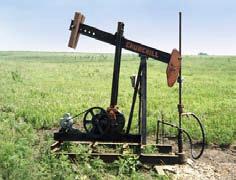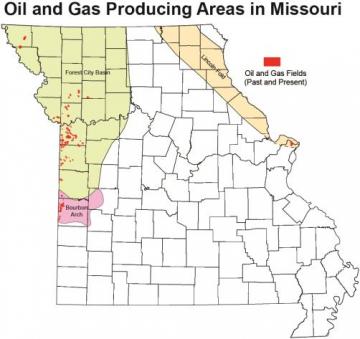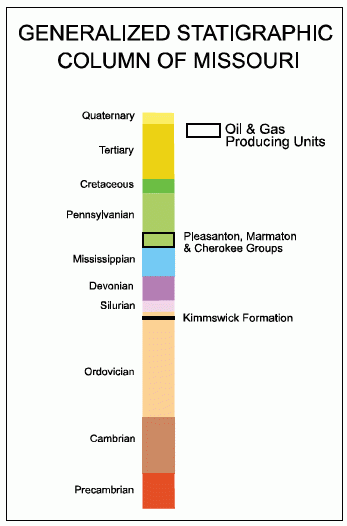Oil and gas are naturally occurring, combustible hydrocarbon substances. Oil is also called petroleum or crude oil. Gas is also known as natural gas. Oil is a very complex mixture of hydrocarbon liquids, whereas gas is simply methane gas that contains small to trace amounts of other gasses, including: ethane, propane, butane, nitrogen, carbon dioxide and helium. Varying amounts of gas are dissolved in most oils.
Oils are classified as light, intermediate and heavy based on their consistency at room temperature. Light oils are thin and flow readily like water or paint thinner. Their color ranges from pale yellow to nearly colorless. Intermediate oils have a syrupy consistency, with colors ranging from green to black. Heavy oils are thick and flow like molasses or not at all. Their color usually is black. The majority of Missouri’s oil is in the intermediate to heavy range.
Oil and gas are both classified as sweet or sour, based on the amount of sulfur content. Sweet oil and gas have little or no sulfur and are considered high quality. Sour oil and gas contain undesirable amounts of sulfur, usually in the form of hydrogen sulfide, which smells like rotten eggs. Missouri’s oil and gas deposits are considered to be sweet.
Oil and gas forms from the burial and thermal alteration of shale or mudstone containing abundant organic material from dead marine organisms. Tiny amounts of oil and gas are produced in the shale or mudstone. Under certain geologic conditions, oil and gas migrate and accumulate into pools. The pools typically are located in porous strata such as sandstones, conglomerates or fractured limestones and dolomites. These pools are trapped in the reservoir strata by impervious layers of shale within a geologic structure such as an anticline.
In Missouri, the first oil and gas wells were drilled in the Kansas City area shortly after the Civil War in the 1860s. Hundreds of shallow wells were drilled in western Missouri along the Kansas border during the late 1800s and early 1900s. Many of these wells produced gas used in private homes, farmsteads and small towns.
Due to the success of these wells, additional sites were explored in central and eastern Missouri. By the early 1930s, more than 2,500 wells had been drilled in search of oil and gas resources. Additional pools were discovered in Vernon County in the 1920s, Caldwell County in 1940, Atchison County in 1942, Clinton County in 1952 and St. Louis County in 1953. Missouri’s newest field along the Holt and Atchison county border was discovered in 1987.
There are three areas of current oil and gas production in the state: the Forest City Basin in northwestern Missouri, the Bourbon Arch in western Missouri and the Lincoln Fold in northeastern Missouri. Within these fields, oil and gas production comes from two producing zones: the Pennsylvanian-age Pleasanton, Marmaton and Cherokee groups and the Ordovician-age Kimmswick Formation. The depth of production in the Cherokee Group ranges from less than 200 feet in the Eastern Field of Vernon County to more than 1,500 feet in the Tarkio Field in Atchison County. Production in the Kimmswick Formation ranges from 1,200 feet in the Florissant Dome in St. Louis County to more than 2,800 feet in the Runamuck Field in Atchison County.

Producing intervals in the Pennsylvanian come from sandstones and black shales. The Ordovician Kimmswick is a fractured limestone. The structures most commonly associated with oil and gas production are anticlines (or elongated domes) and typically do not extend for more than one-quarter mile. In 2006, Missouri produced nearly 90,000 barrels of oil from 323 wells in five counties (Atchison, Cass, Jackson, St. Louis and Vernon). This oil was worth approximately $4.87 million. While there is currently no gas produced for commercial sale in the state, gas was produced for private use from 45 registered wells. Additionally, two large wells produced gas for a private company.
The Missouri Geological Survey has a number of publications about petroleum production and exploration including: OFR-90-80-OG, Heavy-Oil Resource Potential of Southwest Missouri; RI-1, Recent Drilling in Northwestern Missouri; V-27, The Oil and Gas Resources of Cass and Jackson Counties Missouri; OFM-81-54-OG, Oil and Gas Fields of Missouri, as well as maps and other publications. Some are historical documents written in the early 1900s.



